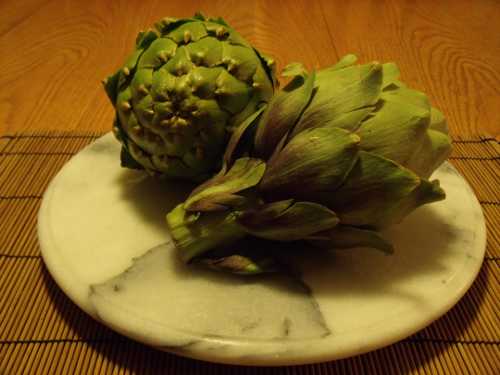
Artichokes are the immature buds of a plant in the thistle family. Photo by Esther Oertel.
Oh, prickly globe of humble leaf
Grown on ocean cliffs so steep
You woo us with your inner heart
Your thorns shock fingers like a dart
We seek you for your tasty flesh
And love you when you’re on our dish
We dig through leaves for our reward,
That tender disc which thorns do guard
Oh, artichoke, how you please!
With oil, butter, or mayonnaise
We peel a leaf, we take a bite
(What’s left behind does look a sight!)
Oh, artichoke, you’re worth the time
It takes to eat your parts sublime
You make for us a mighty feast
With heart, and each and every leaf
Groaning aside, the artichoke is a vegetable worthy of an ode, don’t you think? It’s mysterious, after all, as well as metaphorical and unique.
As to mystery, who ate the first one? What prompted that curious soul to look past the thorns and discover tasty flesh inside?
Its thorny leaves and tender heart evoke endless metaphors:
You can’t judge a book by its cover.
Good things take time.
Life unfolds like the leaves of an artichoke.
One must dig deep for hidden treasure.
A thorny exterior belies a tender heart within.
Patience wins all.
And its uniqueness speaks for itself. There is no other vegetable quite like it.
Almost 100 percent of the U.S. artichoke crop is cultivated in California, with Monterey County – specifically Castroville and surrounding areas – accounting for a whopping 75 percent of it. Apparently the moderate coastal clime of that area and its fog-shrouded fields bode well for its growth.
Not surprisingly, Castroville, which has hosted an artichoke festival since 1956, has been dubbed the artichoke capital of the world.
And the town has an additional, if lesser known, claim to fame: Marilyn Monroe, then a barely recognizable starlet, was crowned Castroville’s artichoke queen in 1948.
Artichoke plants are large, with spiny, arching, ferny leaves that spread to up to 6 feet in diameter and stalks that grow to about three or four feet in height.
Edible artichokes are officially known as globe artichokes, and there are a number of varieties in varying sizes and shades of green and purple.
The part we eat is actually an immature bud which develops in various sizes depending on which part of the stalk it resides. The largest artichokes grow at the top of the stalk, medium ones grow from side shoots, and “baby” (or petite) artichokes grow at the base of the stalk hidden in the leaves.
“Baby” artichokes are fully mature but of a smaller size. The fuzzy portion near the heart doesn’t develop on them, making them easier to prepare.
If the buds are allowed to mature, they flower into a violet, thistle-like bloom, appropriate for this member of the thistle group of the sunflower family.
Artichokes grow wild in southern Europe and northern Africa and were first developed for cultivation in Sicily, Italy. They were later cultivated by the African Moors near Granada, Spain in about 800 A.D.
It was Spanish settlers who brought them to California in the 1600s, but they didn’t achieve popularity here until more than three centuries later, in the 1920s.
They were mentioned in the literature of the Greeks and Romans as far back as 77 A.D. In fact, shortly before his death, Pliny the Elder, an oft-quoted Roman author and naturalist, said they were one of “earth’s monstrosities.” Clearly he wasn’t a fan.
Artichokes contain more than nine powerful antioxidants that contribute to our health in a diverse array of ways, from promoting cardiovascular health to inhibiting the growth of cancer cells to aiding in the regeneration of liver tissue.
They’re also full of fiber, vitamin C, magnesium and potassium.
The best artichokes are globes that are heavy for their size with tight leaves. Don’t choose those that are dry looking or turning brown. If leaves are open, it means the artichoke is past its prime.
Artichokes may be stored in your fridge in a plastic bag, unwashed, for up to four days.
Before using, wash artichokes well, and if home grown, be sure to tap them upside down in the sink. This helps remove any critters that may have made the leaves their home.
Artichokes are most commonly steamed, but they can be boiled, grilled, or roasted. If using the latter two methods, I recommend parboiling them first to tenderize the leaves and then finishing on the grill or in the oven to infuse the rich, smoky flavor that these methods impart.
When steaming, the top half inch or so may be cut off to remove prickly thorns and, for the same reason, the tips of each leave may be trimmed with scissors. I often slice artichokes in half to reduce the cooking time. I clean out the fuzz near the heart before popping into the steamer.
Artichoke stems are tasty and needn’t be completely removed before cooking. A couple inches may be left intact and lightly peeled.
A garlic clove, bay leaf, or slice of lemon (even all three) may be added to the water that steams the artichokes to impart flavor.
Artichokes may be served cold or hot, and are often accompanied by mayonnaise (usually when served cold), melted butter, or garlic-infused olive oil. I especially love them with a sauce of mayonnaise, freshly squeezed lemon juice, and fresh dill.
In Italy and parts of France, raw artichoke hearts are shaved and tossed in salads with a vinaigrette dressing and shavings of Parmigiano-Reggiano cheese.
In Sicily, a mixture that includes bread crumbs, garlic, olive oil, anchovies, and cheese is stuffed between the bracts (the official term for an artichoke’s leaves) and then baked in the oven.
Polish cooks braise artichoke hearts in white wine and garlic, while Moroccans bake them with lamb.
I have to say that the most unusual use of artichokes I’ve seen is in the Italian liqueur cynar. This bitter aperitif is made with 13 different plants, the most predominant being the artichoke.
If you’re looking for heart-themed meal ideas for tomorrow’s St. Valentine’s Day festivities, look no further than the cream of artichoke heart soup I offer below. Its delicate flavor and creamy texture marry well with a salad of hearts of Romaine lettuce tossed in simple vinaigrette.
The recipe is a spin on one by Giada De Laurentiis of the Food Network. If frozen artichoke hearts are unavailable, canned or home-cooked ones may be used. (Just be sure the canned variety is not marinated.)
As to my ode, I may have broken some poetry etiquette through its creation. According to thinkquest.org, “An ode is a poem that is written for an occasion or on a particular subject. They are usually dignified and more serious as a form than other forms of poetry. Unfortunately, today's society has distinctly less respect for propriety, morality, and dignity. Modern odes include sarcastic poems about various subjects, including Velcro and vegetables.”
I hope you’ll forgive me. At least mine wasn’t sarcastic; I meant every word.
Cream of artichoke heart soup
2 tablespoons extra-virgin olive oil
2 leeks, white part only, washed well and chopped
1 clove garlic, minced
1 small potato, peeled and chopped
1 (8 or 10 ounce) package frozen artichoke hearts, thawed
2 cups stock of your choice
½ teaspoon salt
Freshly ground black pepper
¼ - ½ cup heavy cream
Heat olive oil in a heavy, large pot over medium heat.
Add the leeks and the potatoes and cook for 5 minutes, stirring often.
Stir in the garlic and cook for another minute.
Add the artichokes, stock, salt, and pepper and cook until the vegetables are tender, about 20 minutes.
Off heat, use a handheld immersion blender to puree the soup.
Add the cream to taste and blend again to combine.
Taste and adjust the seasoning, if needed, and heat to serving temperature.
Makes about four servings.
Esther Oertel, the “Veggie Girl,” is a culinary coach and educator and is passionate about local produce. Oertel teaches culinary classes at Chic Le Chef in Hidden Valley Lake, Calif., and The Kitchen Gallery in Lakeport, Calif., and gives private cooking lessons. She welcomes your questions and comments; e-mail her at This email address is being protected from spambots. You need JavaScript enabled to view it..
Follow Lake County News on Twitter at http://twitter.com/LakeCoNews , on Facebook at http://www.facebook.com/pages/Lake-County-News/143156775604?ref=mf and on YouTube at http://www.youtube.com/user/LakeCoNews .












